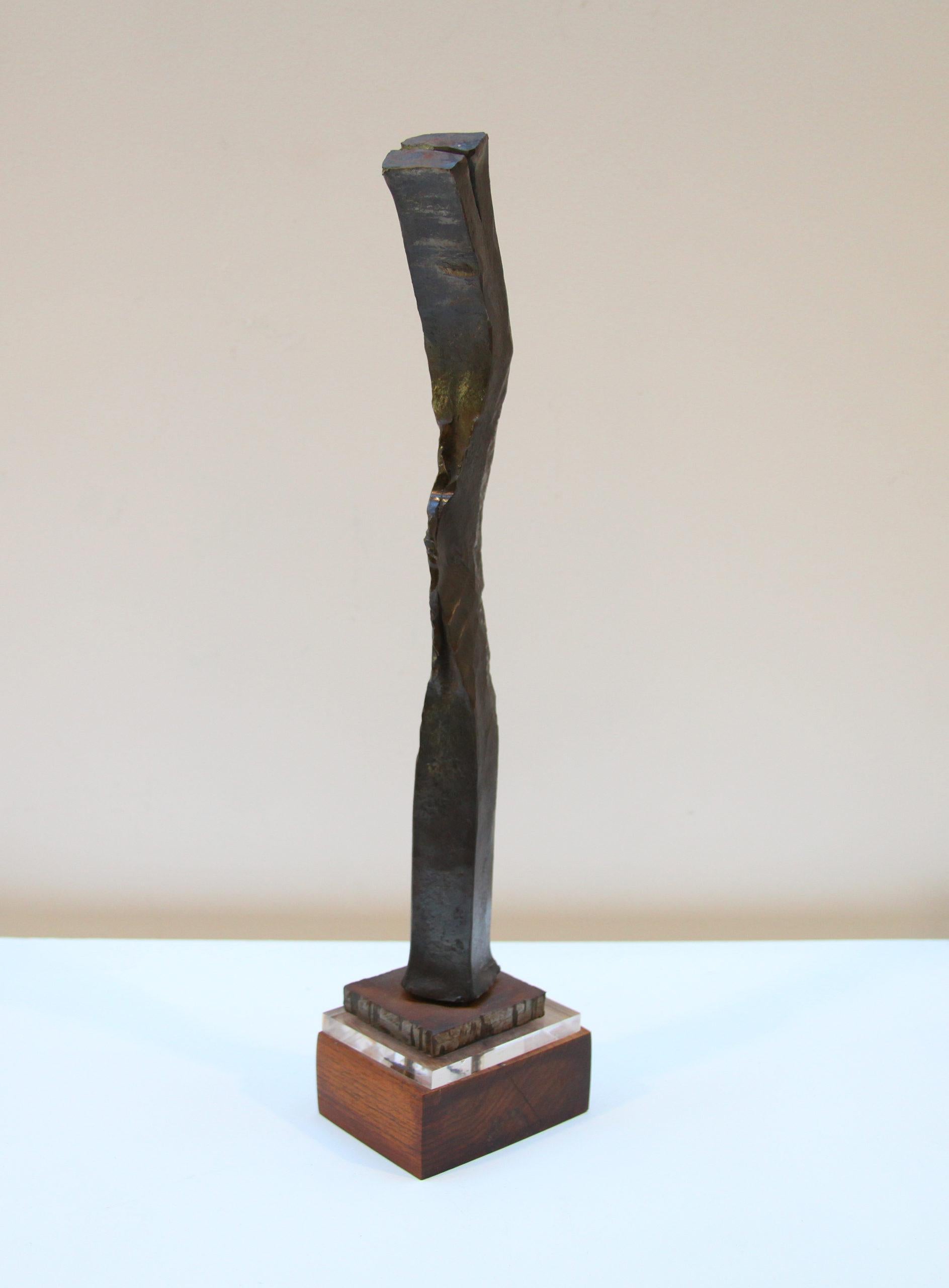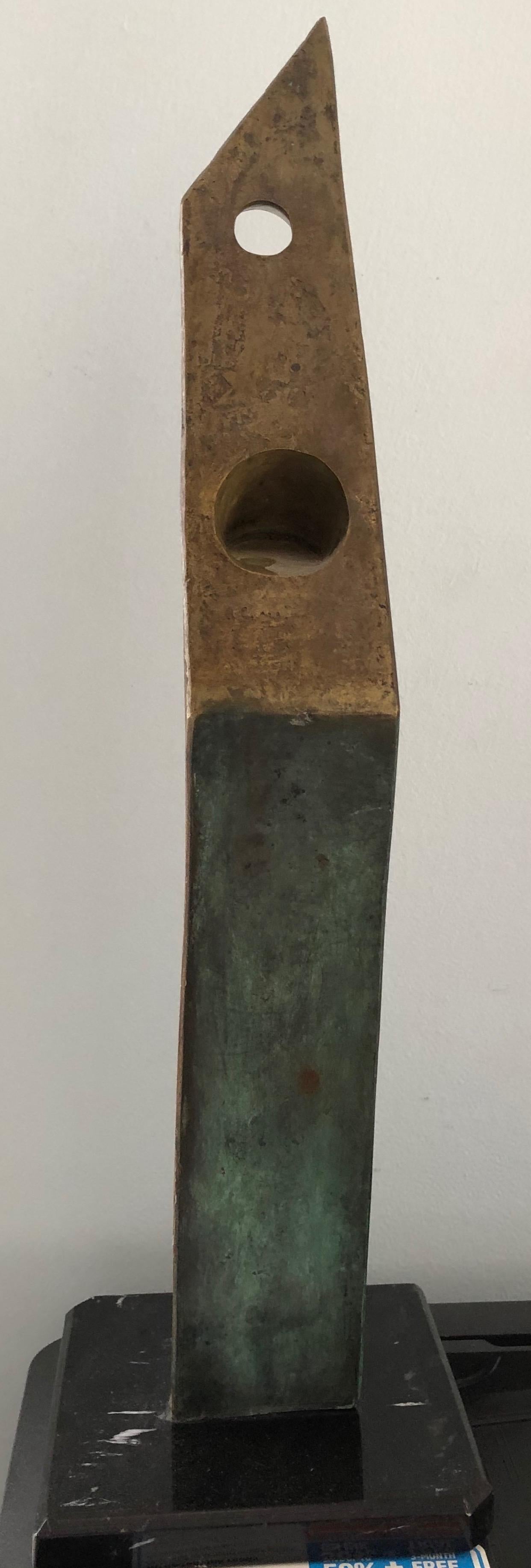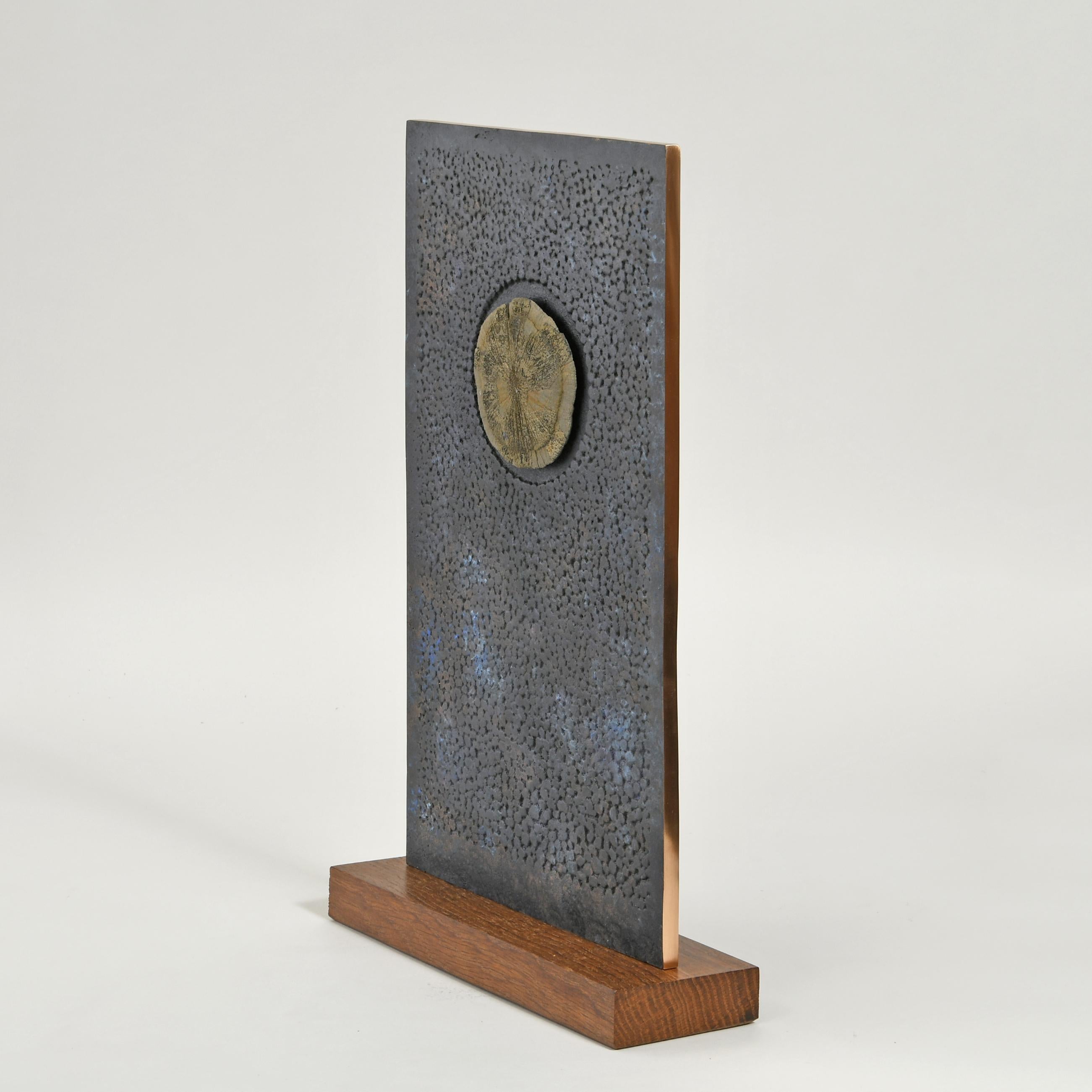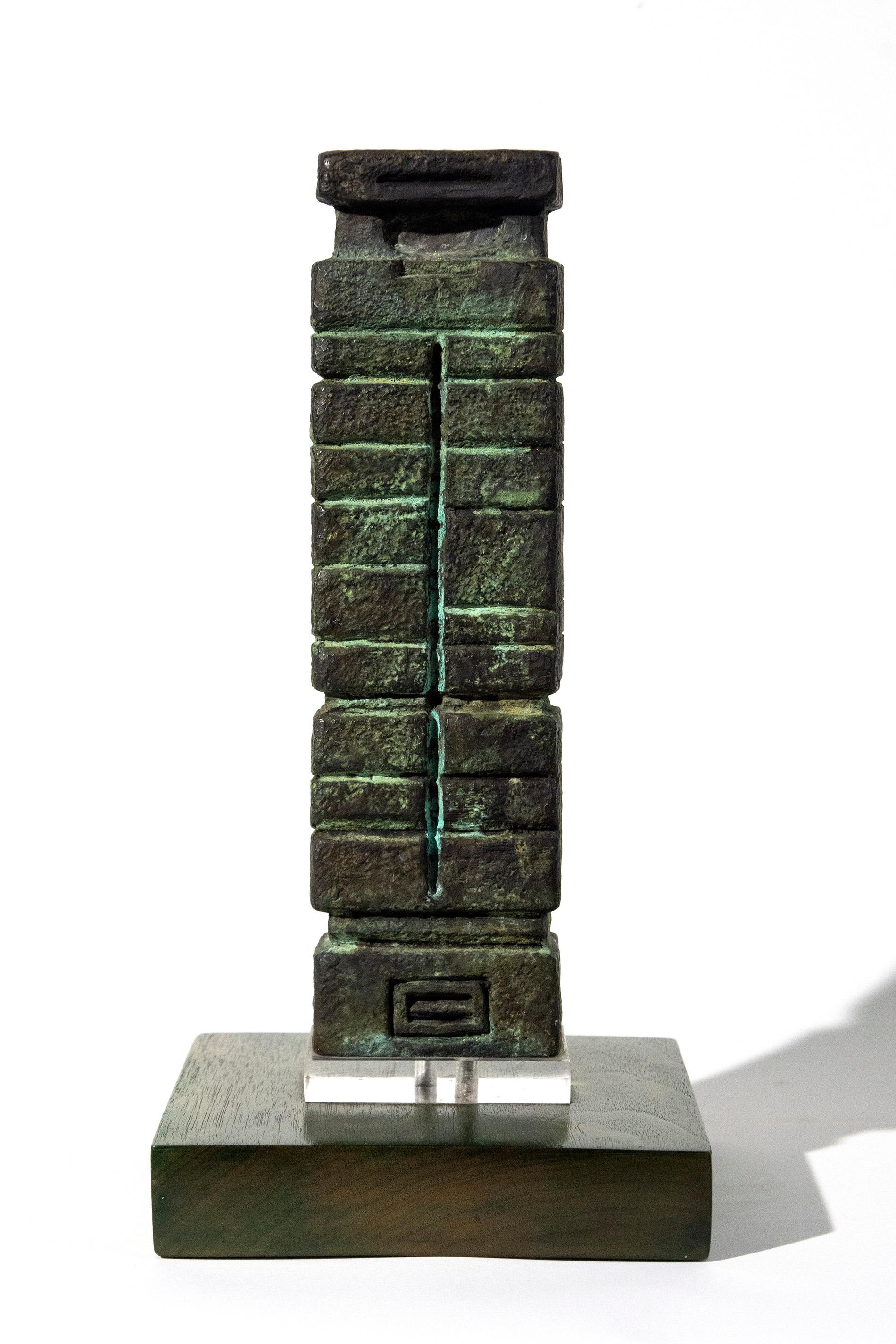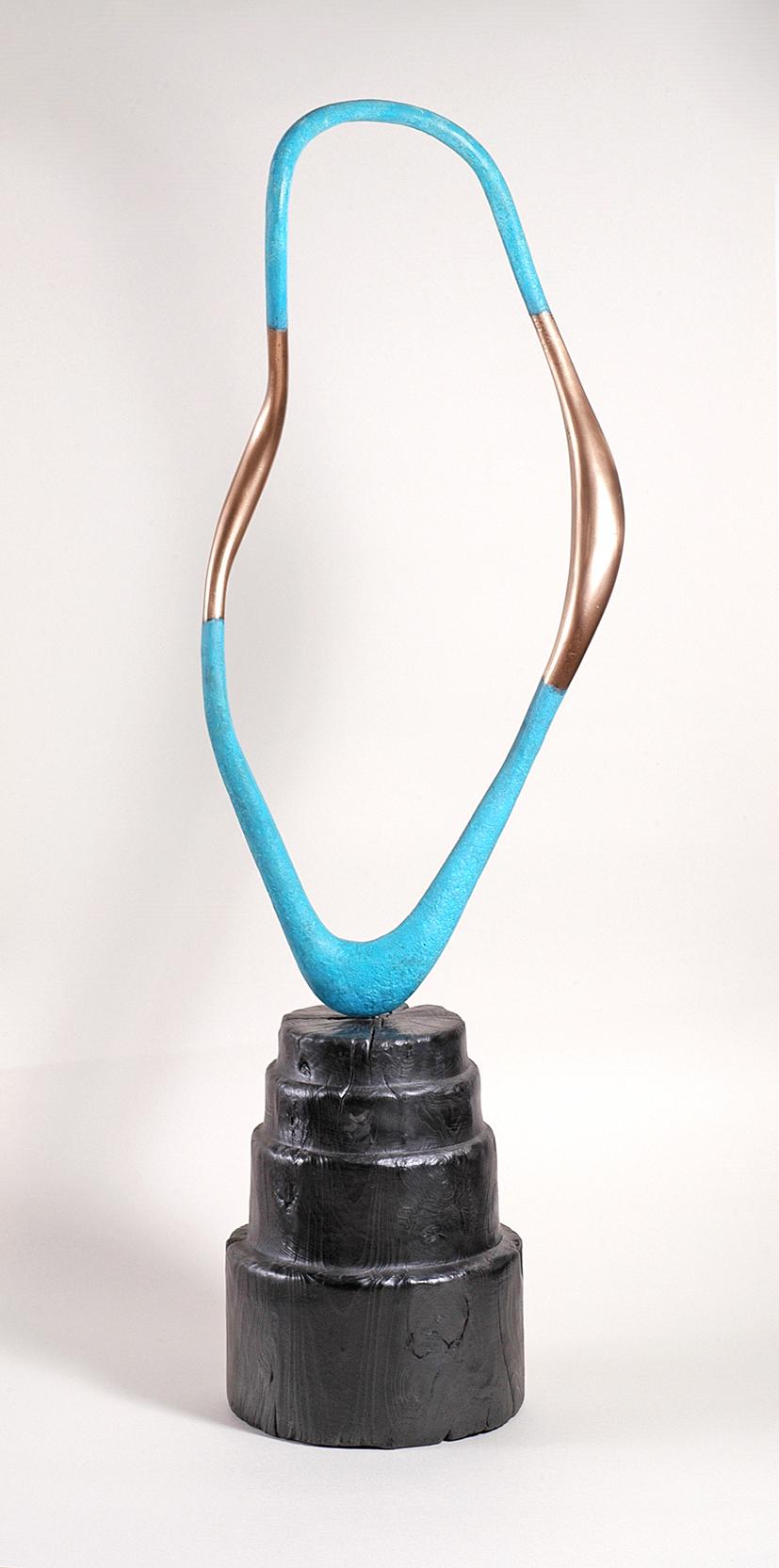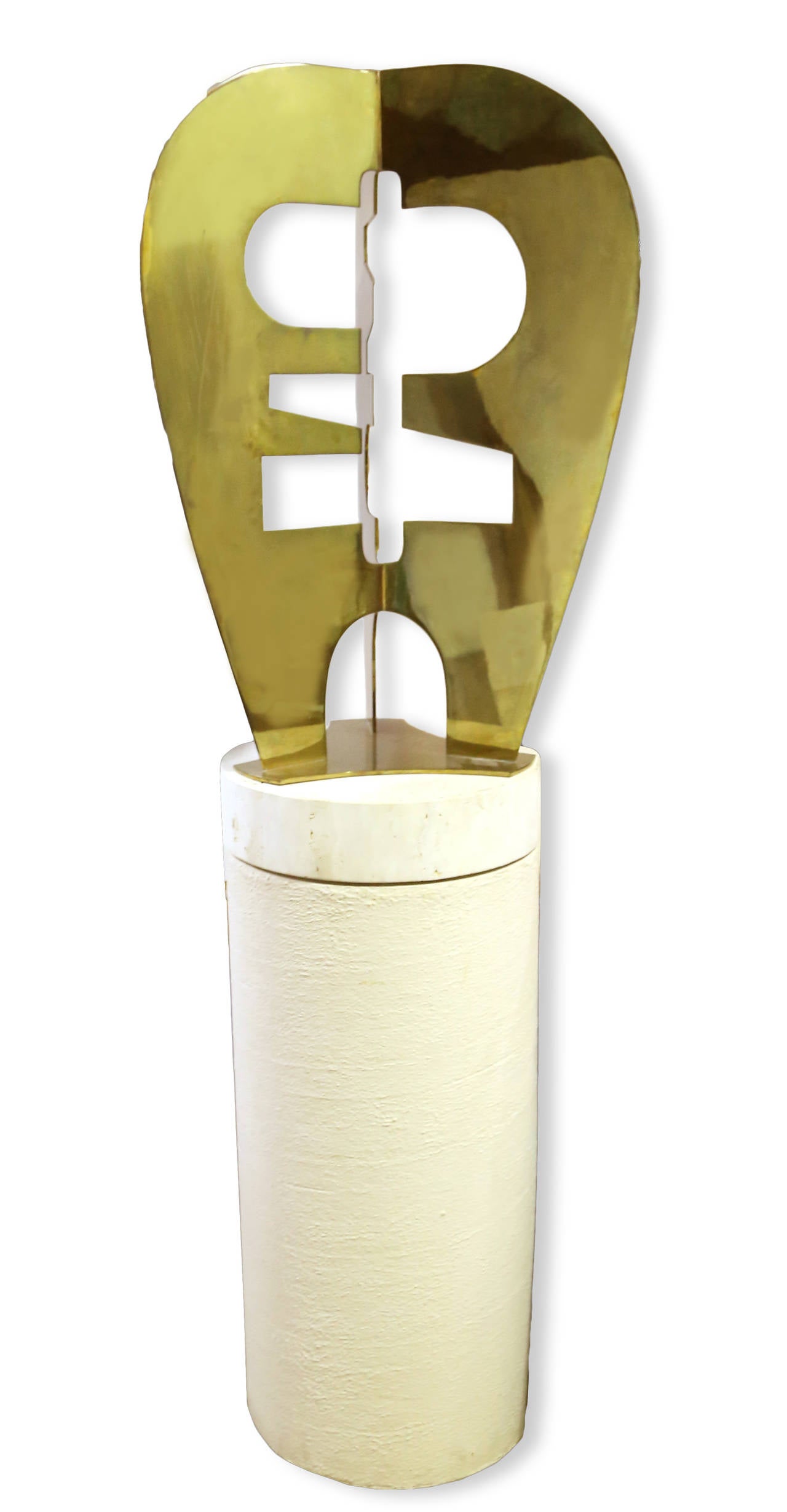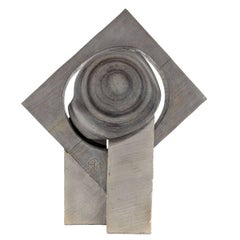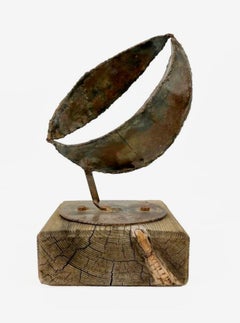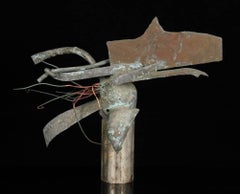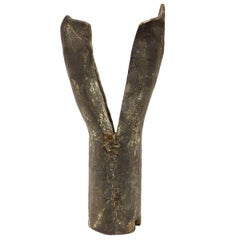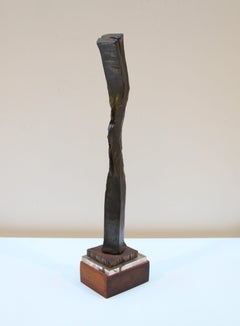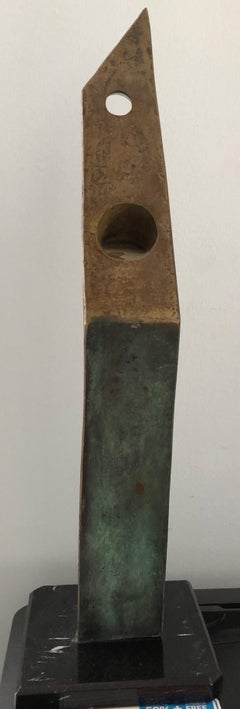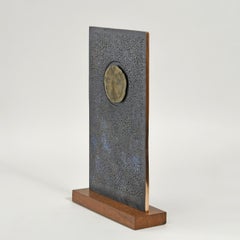Items Similar to Scottish Abstract Contemporary Minimalist Art Bronze Sculpture Alan Johnston 2/2
Want more images or videos?
Request additional images or videos from the seller
1 of 15
Alan JohnstonScottish Abstract Contemporary Minimalist Art Bronze Sculpture Alan Johnston 2/21988
1988
$10,000
£7,438.31
€8,708.79
CA$13,953.40
A$15,614.24
CHF 8,153.02
MX$191,960.85
NOK 102,859.79
SEK 96,790.55
DKK 64,974.26
Shipping
Retrieving quote...The 1stDibs Promise:
Authenticity Guarantee,
Money-Back Guarantee,
24-Hour Cancellation
About the Item
Alan Johnston (Scottish, born 1945),
Untitled, 1988, cast bronze, edition of 2, cast #2
Incised A.J. 2/2 88 on underside
Provenance: Jack Tilton Gallery, NY
This is a weighty, solid bronze sculpture mounted to a clear, lucite, acrylic or plexiglass base
Alan Johnston, one of the leading British geometric abstract artists of his generation. Known for his large-scale architectural interventions and wall drawings including collaborations with architects such as Diener & Diener in Basel, Reiach & Hall architects Edinburgh, Shinichi Ogawa architects Tokyo and Hiroshima and Shinichi Ogawa in Japan, in 2013, he was commissioned to create a large ceiling drawing as part of the refurbishment of Tate Britain.
His work has its roots in the practice of art, architecture and visual thinking in the West and the East, and relates to concepts and practices such as Wabi Sabi and Minimalism. His work is also related to the work of Patrick Geddes. He has engaged in collaborative initiatives in art and architecture with Professor Shinichi Ogawa, Tokyo, and Neil Gillespie, Edinburgh.
Lives and works in Edinburgh, Scotland
EDUCATION
1972 - 73 Kunstakademie, Düsseldorf
1969 - 72 Royal College of Art, London
1964 - 69 Edinburgh College of Art, Edinburgh
SELECT SOLO EXHIBITIONS
2015 Alan Johnston, H-I-C-A, Inverness-shire, Scotland, UK
2015 SAFN, Berlin, Germany
Mies van der Rohe Haus, Berlin, Germany
2013 Bartha Contemporary, London, UK
Wall Drawing, Tate Britain, London, UK
2012 Drawing A Shadow: No Object. Henry Moore Institute, Leeds, UK
2011 Spazio attivo ovvero struttura: Renata Fabbri Contemporary Art, Milano, Italy
2010 Drawing House of Art. Budejovice, Czech Republic
2010 exhibition at the Henry Moore Institute
2009 Wall Drawing Peloton, Sydney Australia
2008 Wall Drawing U8, Nagoya, Japan
Tanizaki’s Mountains. Concept Space. Gunma, Japan
2007 Encased A.P.U.F.A.M. Museum, Aichi, Japan
Shadow Without Object, NSA Gallery, Hiroshima, Japan
Wall drawing, New Bedford Art Museum. New Bedford, USA
2005 Cairn Gallery Pittenweem Fife, Scotland, UK
1999 Northern Mirror Bury Museum, Bury, Greater Manchester, UK. Exhibition and installation
Two Cubes, I.A.V.A Akiyoshidai International Contemporary Art and Architecture Academy. An
Architectural Collaboration with Shinichi Ogawa, Akiyoshidai, Japan
1998 The Norwich Gallery, N.S.A.D. Norwich
Jack Tilton Gallery, NYC, USA
1996 The Lisson Gallery, London.
1994 Jack Tilton Gallery, NYC, USA
Haus Wittgenstein, Vienna, Austria
1993 Shimada Gallery, Yamaguchi, Japan
1979 Graeme Murray Gallery, Edinburgh, Scotland, UK
1978 Museum of Modern Art, Oxford, UK
1977 Graeme Murray Gallery, Edinburgh, Scotland, UK
1975 Nigel Greenwood Gallery, London, UK
1974 Von Der Heydt Museum, Wuppertal, Germany
SELECT GROUP EXHIBITIONS
2012 A Parliament of Lines, CAC Edinburgh, UK. Including Charles Avery, Paul Chiappe, Layla Curtis, Nathalie De Briey, Moyna Flanagan, Luca Frei, Euan Gray, Sam Griffin, Marie Harnett, Callum Innes, Andrew MacKenzie, David Shrigley, Graeme Todd, Ainslie Yule
2011 Faster and Slower Lines - From the Collection of Pétur Arason and Ragna Róbertsdóttir, The Reykjavik Art Museum, Reykjavik, Iceland. Curated by Birta Gudjondottir and Petur Arason. Including Ingolfur Arnarsson, Birgir Andresson, Stanley Brouwn, Helmut Federle, Ian Hamilton Finlay, Roni Horn, Kristjan Gudmundsson, Donald Judd, Richard Long, Dieter Rot, Karin Sander, Lawrence Weiner
Presente Futuro, Bordarier, Renata Fabbri arte contemporanea, Milano, IT. Inlcuding McLune, Radi,
Sartorio, Shanahan, Thurston
2010 IFF, Marseilles, FR. curated by Gavin Morrison. Including Douglas Gordon, Sean Shanahan, Fraser Stables
2009 Tactile Vision, Slewe Gallery, Amsterdam, Netherlands. Curated and participated group exhibition including Roger Ackling, David Connearn, Yoko Terauchi, Thomas Clark, Andreas Karl Schulze, Eiji Watanabe, Taka Iwasaki, Ragna Robertsdottir, Ian Hamilton Finlay, Takaya Fujii, Thomas Struth, Hideo Shimada, Richard Tuttle, Adam Barker-Mill, On Kawara, Tom Benson, Takashi Suzuki, John McLaughlin, Atsuo Hukuda, Kenzo Onada, Shinichi Ogawa, Yasuko Otsuka, Masayuki Yasuhara
SNO Contemporary Art Projects. 48, Sydney, Australia. Curated by Richard Dunn. Including Mark Brown, Richard Dunn, Marita Fraser, Manya Ginori, Alex Lawler, Adrian McDonald, Ragna Robertsdottir, Tsong Eng Tan
2007 The Secret Theory of Drawing, The Drawing Room, London
Niland Gallery Model Arts Sligo Ireland. Including David Austen, Trisha Donnelly, Olafur Elliasson, Ceal Floyer, Ellen Gallagher, Dominique Gonzalez-Foerster, Douglas Gordon, Patrick Ireland, Alan Johnston, John Latham, Mark Manders, Matt Mullican, Anri Sala, Bojan Šarčević, Joelle Tuerlinckx, Cathy Wilkes
IRRATIONAL THOUGHTS. In Memory of Sol Le Witt. Sol LeWitt, Lolly Batty, David Bellingham, Pavel Buchler, Thomas A Clark, David Connearn, Kenneth Dingwall, Alec Finlay, Alan Johnston, Jonathan Monk, Bernardo Ortiz, Adrian Piper, John Shankie, Lawrence Weiner, Ian Whittlesea.
2005 Exposed-Contemporary Art from the City’s Collection, City Art Centre Edinburgh,
Celebrate, Jack Tilton Gallery. NYC, USA. Including Rickrit Tiravanija, Nancy Spero, Kiki Smith, Ernst
Caramelle, Fabrice Hybert, Douglas Gordon, David Hammons, Marlene Dumas, Francis Alys, Wim
Delvoye, Fred Tomaselli.
Evergreen, Inverleith House, RBGE, Edinburgh, UK. Curated by Paul Nesbitt. Including, Carl Andre, Cy Twombly, Lawrence Weiner, Thomas Struth, Franz West, Douglas Gordon, Rory McEwan, Richard Wright, Agnes Martin, Ruth Vollmer
Per La Musica, Encounter in the Earth of Siena, Casteluccio. Curated by Peter Moser. Including, Michael Biberstein, Mark Staff Brandl, Thomas Clark, Kenneth Dingwall, Janis Kounellis, Bernhard Lüthi, Beverly Pepper, Not Vital, Beat Zoderer
2004 The Director’s Chair, Open Eye Gallery. Edinburgh, Scotland, UK
Künstlerbücher, With Auberger, Eduardo Chillida, Partenheimer, Schütte, Schwegler, Galerie Ute Parduhn. Düsseldorf, Germany
Fifty Years of Supporting The New, The Aldrich Museum. Ridgefield CT, USA. Including Ad Reinhardt, Antoni, Finch, Tomaselli
2001 It must be abstract it must change it must give pleasure, York City Art Gallery, York. Curated by Greville Worthington. Including Alan Davie, Ian Hamilton Finlay, Alan Charlton, Richard Long
1997 Peterburger Hängung Galerie Cora Hölzl, Düsseldorf. With Hans Damisch, Heerich, Klein, Sigmar Polke, Gerhard Richter, Dieter Roth.
1987 Synopsis Gallery, Cora Hölzl, Düsseldorf. With Jean Hans Arp, Joseph Beuys, Richard Tuttle
About the Seller
4.9
Platinum Seller
Premium sellers with a 4.7+ rating and 24-hour response times
Established in 1995
1stDibs seller since 2014
1,777 sales on 1stDibs
Typical response time: 1 hour
- ShippingRetrieving quote...Shipping from: Surfside, FL
- Return Policy
Authenticity Guarantee
In the unlikely event there’s an issue with an item’s authenticity, contact us within 1 year for a full refund. DetailsMoney-Back Guarantee
If your item is not as described, is damaged in transit, or does not arrive, contact us within 7 days for a full refund. Details24-Hour Cancellation
You have a 24-hour grace period in which to reconsider your purchase, with no questions asked.Vetted Professional Sellers
Our world-class sellers must adhere to strict standards for service and quality, maintaining the integrity of our listings.Price-Match Guarantee
If you find that a seller listed the same item for a lower price elsewhere, we’ll match it.Trusted Global Delivery
Our best-in-class carrier network provides specialized shipping options worldwide, including custom delivery.More From This Seller
View AllAbstract Minimalist Geometric Sculpture
By Adolph Dioda
Located in Surfside, FL
Adolph T. DIODA (1915-1991)
Birth place: Aliquippa, PA
Lived in West Aliquippa, PA; Detroit, MI; Phila. & Jenkintown, PA
Profession: Sculptor, educator
Studied: Carnegie Inst Technol; Cleveland School of Art; Barnes Fnd., Art Student League New York, NY; also with John B Flannagan, New York.
Exhibited: WMAA, 1939-40; Carnegie Inst., 1941; AIC, 1940, 1951; Sculpture Int., Philadelphia Mus. of Art, 1940-49; AA Pittsburgh, 1941-45; Carved in Stone, Bucholtz Gallery, New York, 1945; PAFA, 1946-47 & 1968 (prize, 1947); Philadelphia A. All., 1951; Carlen Gal., Philadelphia, 1951; 2-man exh. with William Kienbusch...
Category
1970s Minimalist Abstract Sculptures
Materials
Stone, Marble
1965 Canadian Israeli Art Brutalist Abstract Welded Steel Sculpture Eli Ilan
Located in Surfside, FL
Eli Ilan (אלי אילן), 1928-1982 was an Israeli sculptor.
Abstract organic pod shape. in either steel or iron mounted on a wooden plinth.
Ilan was born in Winnipeg, Manitoba. He enrolled in a premedical curriculum at the University of British Columbia in Vancouver and emigrated to Israel in 1948. He then studied prehistoric archaeology and physical anthropology at the Hebrew University of Jerusalem. In 1956, he returned to Canada to study sculpture at the Ontario College of Art & Design. He lived in Kibbutz Sasa from 1959 to 1963. He died in 1982 in Caesarea, Israel.
Education
1955 Hebrew University, Jerusalem, pre-historic archaeology and physical anthropology
1956 Ontario College of Art, Toronto, Canada, sculpture under Thomas Bowie
1959 Training College, Ottawa, criminal identification techniques
1969 Art Festival, Painting & Sculpture in Israel. Ganei Hataarucha, Tel Aviv
Artists: Chana Orloff, Eli Ilan, Zvi Aldouby, Jacob El Hanani, Ludwig Blum, Aharon Bezalel, Koki Doktori, Israel Hadany, Marcel Janco, Dov Feigin, Abel Pann, Esther Peretz Arad, Reuven Rubin, Ivan Schwebel, Jakob Steinhardt, Boris Schatz, Bezalel (Lilik) Schatz, Louise Schatz...
Category
1960s Abstract Abstract Sculptures
Materials
Stainless Steel
Brutalist Bronze Abstract Modernist Sculpture
Located in Surfside, FL
In the manner of Julio Gonzalez, mixed metal sculpture.
Neo-Dada Abstract Sculpture: Assemblages
Abstract sculpture followed a slightly different course. Rather than focusing on non-figurative subject matter, it concentrated on materials, hence the emergence of Assemblage Art - a form of three-dimensional visual art made from everyday objects, said to be 'found' by the artist (objets trouves). Popular in the 1950s and 1960s in America, assemblage effectively bridged the gap between collage and sculpture, while its use of non-art materials - a feature of Neo-Dada art - anticipated the use of mass-produced objects in Pop-Art. Assemblage sculpture is exemplified by the works of Louise Nevelson (1899-1988), such as Mirror Image 1 (1969, Museum of Fine Arts, Houston), and by Jean Dubuffet (1901-85) and his Monument with Standing Beast (1960, James R. Thompson Center, Chicago). The idiom was considerably boosted by an important exhibition - "The Art of Assemblage" - at the Museum of Modern Art, in New York, in 1961.
Other examples of the Neo-Dadaist-style "junk art...
Category
20th Century Abstract Expressionist Abstract Sculptures
Materials
Bronze, Copper
Minimalist Abstract Bronze Sculpture
By Ruth Vollmer
Located in Surfside, FL
In this abstract sculpture by Ruth Vollmer, the fusion between contrasting concepts: mathematical precision and natural "organicism", materials in both raw and manipulated states are evident. Signed by the artist.
Ruth Vollmer (1903 - 1982 New York City), was a German artist born in Munich. She was born in 1903 and named Ruth Landshoff. Her father, Ludwig Landshoff, was a musicologist and conductor and her mother, Phillipine Landshoff, was an opera singer. Their family was Jewish. At age 19 she began to work as an artist and took the advice of her father to draw every day. She also had many connections to the teachers and students at the Bauhaus. In 1930 she married a pediatrician named Hermann Vollmer, whom she met in Berlin. Ruth and Hermann move from Germany to New York in 1935. Ruth begins work designing window displays for Bonwit Teller, Tiffany's, Lord & Taylor, and other department stores. Her displays experimented with wire, steel, and copper mesh to create figural forms. In 1943, Vollmer becomes a U.S. citizen. In 1944 she receives a commission from the Museum of Modern Art for its fifteenth anniversary exhibition, "Art in Progress." Vollumer continues to work with wire mesh and shows her work Composition in Space at the Museum of Modern Art's 1948 exhibition "Elements of Stage Design." In 1950, she was commissioned to create a mural for the lobby of 575 Madison, where Vollmer created a large wall relief that used wire rods and wire mesh to play with light, texture, and transparency. Vollumer visits Giacometti for a second time during the summer of 1951. During the 1950s she begins to works with clay as well. Additionally, in 1954 she begins to teach at the Children's Art Center at the Fieldston School in Riverdale and continued to teach until the mid-sixties. In 1960, Vollmer participates in the NYU discussion series "Artists on Art" with her friend Robert Motherwell. 1960 is an important year because she also has her first one-person exhibition at Betty Parson's Section Eleven gallery space. Throughout the 1960s Vollmer works with bronze and as well as showing at Betty Parson's gallery several times. In 1963, she joins the group American Abstract Artists (AAA) and includes her work in their exhibitions from 1963 on. By 1970 Vollmer's art is working with complex geometrical forms and mathematical concepts, particularly spirals and platonic solids. Sol LeWitt wrote a short essay on Vollmer's work for Studio International titled "Ruth Vollmer: Mathematical Forms." Vollmer protests the cancellation of the Hans Haacke at The Solomon R. Guggenheim exhibition by writing a letter to the director, Thomas Messer, in 1971. In 1976, she had a large one-person exhibition at the Neuberger Museum of Art. In 1982, Ruth Vollmer dies after a long battle with Alzheimer's. A majority of her large personal art collection of over one hundred sculptures, paintings, and drawings is donated to MoMA. Her art collection included works by Carl Andre, Mel Bochner, Eva Hesse, Sol LeWitt, Ad Reinhardt, Frank Stella, Agnes Martin, and Vardea Chryssa.
Exhibitions
1977, Group Exhibition, Betty Parsons Gallery. Mino Argento...
Category
20th Century Minimalist Abstract Sculptures
Materials
Bronze
Mid Century Modern Brutalist Welded Abstract Expressionist Sculpture
Located in Surfside, FL
Neo-Dada Abstract Sculpture: Assemblages
In contrast, abstract sculpture followed a slightly different course. Rather than focusing on non-figurative subject matter, it concentrated...
Category
Mid-20th Century Abstract Expressionist Abstract Sculptures
Materials
Metal
Aharon Bezalel Israeli Modernist Sculpture 2 Parts Minimalist Aluminum or Steel
By Aharon Bezalel
Located in Surfside, FL
A suite of 2 sculptures. Lovers, man and woman nestled together. sleek minimalist mod sculpture.
polished finish on one side. not sure if theese are stell or aluminium. they are cast and signed in Hebrew with initials and numbered 9/9. It is 2 parts that nest together.
Aharon Bezalel (born Afghanistan 1926) Born in Afghanistan in 1926 and immigrated to Israel at an early age. As a youth was engaged as a silversmith and craftsman, and was a student of the sculptor Zev Ben-Zvi from whom he absorbed the basic concepts of classic and modernist art and interpreted, according to them, ideas based on ancient Hebrew sources.
Aharon Bezalel works and resides in Jerusalem, he taught art for many years.
“I saw myself as part of this region. I wanted to find the contact between my art and my surroundings. Those were the first years of Jean Piro’s excavations at the Beer-Sheba mound. They found there, for example, the Canaanite figurines that I especially liked and that were an element that connected me with the past and with this place.” “…a seed and sperm or male and female. These continue life. The singular, the individual alone, cannot exist; I learned this from my father who dabbled with the Kabbalah.”
(Aharon Bezalel, excerpt from an interview with David Gerstein)
“The singular in Aharon Bezalel’s work is always potentially a couple if not a threesome, the one is also the many: when the individual is revealed within the group he will always seek a huddling, a clinging together.
The principle of modular construction is required by this perception of unity and multiplicity, as modular construction in his work is an act of conception or defense.
Two poles of unity, potentially alone, exist in Aaron Bezalel’s world: From a formal, sculptural sense these are the sphere and pillar, metaphorically these are the female in the final stages of pregnancy and the solitary male individual. Sphere-seed-woman; Pillar-strand-man. The disproportional, small heads in Aharon Bezalel’s figures leave humankind in it’s primal physical capacity. The woman as a pregnancy or hips, the man as an aggressive or defensive force, the elongated chest serves as a phallus and weapon simultaneously.
(Gideon Ofrat)
EIN HAROD About the Museum's Holdings: Israeli art is represented by the works of Reuven Rubin, Zaritzky, Nahum Gutman, Mordechai Ardon, Aharon Kahana, Arie Lubin, Yehiel Shemi...
Category
1970s Minimalist Abstract Sculptures
Materials
Metal
You May Also Like
An Abstract Steel Metal Sculpture, "Untitled Steel Sculpture"
Located in San Diego, CA
A one of a kind 3" x 18" x 4" Abstract Steel Metal Sculpture executed by artist James Hubbell. A certificate of authenticity will be provided upon its purchase.
James Hubbell is an...
Category
2010s Abstract Abstract Sculptures
Materials
Steel
Enrique "Sebastian" Carbajal Modernism Bronze Sculpture
By Enrique Sebastian Carbajal
Located in San Francisco, CA
Enrique "Sebastian" Carbajal (Born 1947) bronze sculpture
Brilliant bronze sculpture by listed Mexican artist Enrique "Sebastian" Carbajal.
This Mexican modernist bronze sculpture sits atop a marble base.
Signed in the bronze.
The base measures: 4.5" wide x 3" deep. The sculpture stands 24" tall.
Sebastián (born Enrique Carbajal González...
Category
Late 20th Century Abstract Abstract Sculptures
Materials
Bronze
British Contemporary Sculpture by Philip Hearsey - Halos III
By Philip Hearsey
Located in Paris, IDF
40 high x 23 x 8 cm
Bronze with ferrite inclusion on an oak base
Stamped with monogram signature and uniquely numbered 501C
Series of unique inclusion variations.
The face side with a textured surface has a circular indent incorporating an ancient Pyrite sun...
Category
2010s Abstract Abstract Sculptures
Materials
Bronze
Dynest - modern, abstract, totemic, bronze sculpture
Located in Bloomfield, ON
Elza Mayhew (1916-2004) was known for her abstract bronze sculptures, many large scale, that were described by Colin Graham of the Art Gallery of Greater V...
Category
1970s Abstract Abstract Sculptures
Materials
Bronze
British Contemporary Sculpture by Philip Hearsey - Acanto IV
By Philip Hearsey
Located in Paris, IDF
Year 2016
73 x 26 high x 18 cm
Bronze freely rotating on a scorched yew base.
Series of individual variations
Stamped with monogram signature and uniquely numbered 619A
Parts of th...
Category
2010s Contemporary Abstract Sculptures
Materials
Bronze
Untitled Bronze Sculpture
By Henry Moretti
Located in Long Island City, NY
Artist: Henry Moretti, French/American
Title: Untitled
Medium: Bronze Sculpture
Size: 35 x 24 x 23 in. (88.9 x 60.96 x 58.42 cm)
Base: 37 x 17 x 17 inches
Category
20th Century Contemporary Abstract Sculptures
Materials
Bronze
